I love research, and writing historical fiction demands an understanding of context. On this page I post little-known, or difficult to discover, sources I’ve used in my fiction writing and where they can be found. I don’t have a clear way of sorting these sources other than alphabetically by topic (that’s the “spatter” aspect of the page), but I consider this page an annotated bibliography of sorts, and encourage readers to investigate further. I believe our understanding of history profoundly affects our decisions and plans for today and for the future.
Ciro’s Nightclub Interior
Millar, M. (Writer), & Avery, T. (Director). (1941, May 24; reissue 1948, October 2). Hollywood Steps Out. [Cartoon.] Burbank, CA: Warner Brothers. Retrieved from http://www.b99.tv/video/hollywood-steps/
During the Golden Age of Hollywood, Ciro’s was considered the best, the most important, dinner club. Although other iconic nightclubs drew their share of publicity and secured a place in Hollywood history (Preston Sturges’ The Players, for example, appears at the beginning of Raymond Chandler’s 1953 novel The Long Goodbye, loosely disguised as The Dancers), Ciro’s was the ultimate expression of Hollywood’s social structure. Dining at Ciro’s signaled to others that you’d “made it.”
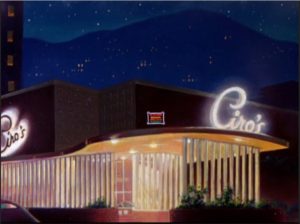
A still from the cartoon “Hollywood Steps Out” shows the Ciro’s exterior
The majority of photographs depicting the nightclub’s interior are black and white, especially early photos, so it’s difficult to get a sense of color and design. Fortunately, Warner Brothers crafted a cartoon entitled “Hollywood Steps Out” that immortalizes an early iteration of the Ciro’s interior. The cartoon is packed with caricatures of Hollywood greats, from Cary Grant to Sonje Henie, with jokes aplenty that would have been clear to contemporary audiences. For me, though, it’s the cartoon’s background that shines.
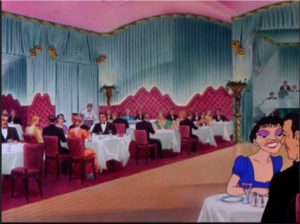
The backdrop for the Warner Brothers cartoon “Hollywood Steps Out” is the beautiful Ciro’s interior
We are taken inside Ciro’s to look around and admire. We stand by the hatcheck or next to the stage and relive what it was like to walk through those rooms. Readers interested in historical interior design, especially Hollywood Regency, may find the cartoon as fascinating as I do.
If you’re interested in the cartoon’s caricatures and inside jokes, the Wikipedia page on “Hollywood Steps Out” is thorough.
Margaret Herrick Library
Margaret Herrick Library. Fairbanks Center for Motion Picture Study, Academy of Motion Picture Arts and Sciences. California: Beverly Hills. Databases available at http://www.oscars.org/library.
This library is like no other. First, its material is entirely non-circulating, so although you can browse online databases, in order to view or read any of the library’s holdings, you must go in person and have a darned good reason for wanting to look. The librarians are fantastic and helpful, and not all of the collections are available by reservation only. The accessible stacks at the library are few but interesting. I have spent many days at the Herrick Library, and on breaks from my work I would browse the stacks and close my eyes, then select a book. A wonderful way to find out information I didn’t even know I wanted! Who knew that Bette Davis had an abortion in the fall of 1940?
One focus of my past research has been the periodicals. Fortunately, many movie periodicals are now accessible online (try the database at https://archive.org). However, if you can’t find what you need, the Herrick Library probably has it. While at the library I have read all the Photoplays and Movie Mirrors for 1940 and 1941.
The special collections of the Herrick Library are really the star of this show. The library holds the George Cukor papers, Mary Pickford papers, Hedda Hopper papers, Cary Grant papers, Edith Head papers, Paul Henreid papers, Alfred Hitchcock papers, Douglas Fairbanks papers, Harold Lloyd papers, and on and on. There are collections of many more people associated with the film industry, and script after script used throughout a movie’s production. The library’s special collections also holds a couple locks of hair, and fascinating fan scrapbooks. I once spent an afternoon at the Herrick Library using the requisite white gloves to go through a thick file of loose photographs and newspaper clippings on Adolph Zukor, just to find out how his Paramount office had been decorated.
Yes, I did get the info I needed.
Photo Collection of the Los Angeles Public Library
Photo Collection. Various dates. Los Angeles: Los Angeles Public Library. Online collection available at http://www.lapl.org/collections-resources.
One of the first stops for anyone interested in Southern California social history is the Los Angeles Public Library. The photo collection includes 60,000 online historic photos, and many, many more photos are in the collection but not available online. You can get information by emailing the library’s photo curator. A number of organizations and private parties have donated their collections to the library, including the Herald-Examiner photograph morgue (not morgue photos, although there are a few of those, but the photos previously stored by the now-defunct Los Angeles Herald-Examiner). Some of these photos are used, with permission, on my website.
The LAPL collection includes vintage crime photos; some of these are used as headers on my website, although I have cropped them for space and anonymity. A selection of these vintage crime photos (all from the LAPL) are available for viewing at http://www.lamag.com/citythinkblog/returning-to-the-scene-of-the-crime-photos-from-behind-the-caution-tape/.
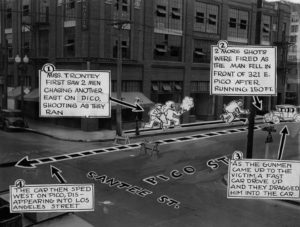
The Herald-Examiner narrates a witness’s tale of a 1930 shooting in Los Angeles. Photo courtesy of the Los Angeles Public Library.
Some of my favorite photos in the LAPL collection are from the now-defunct Los Angeles newspaper Herald-Examiner, and include drawings or mark-ups for publication. The photo at right, for example, narrates the scene of a 1930 shooting. The suspects stole a car, kidnapping the driver.
The collection also has photos of celebrities and movie stars, movie studios, cultural diversity, newsworthy trials, neighborhoods and architecture, and pretty much any topic you can think of. I appreciate the collection as a research source because most often the photos available at the LAPL are not seen other places on the internet.
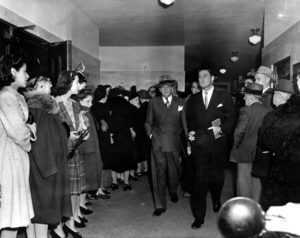
Errol Flynn, 1943, at his trial. He was accused, and acquitted, of statutory rape. Attorney Jerry Giesler accompanies him. Photo courtesy of the Los Angeles Public Library.
Take, for example, the photo on the left: Errol Flynn going to court in 1943. Often trials were the few places where movie stars revealed themselves in ways not scripted by their studios. Note, too, the line of female admirers. At a rape trial. For me, this photo tells Flynn’s story: a man incapable of defining consequences walks by a wall of temptation.
In terms of Hollywood photography, there are other sources online, but those require payment. At the LAPL payment is necessary in certain situations, such as ordering an enlarged print of the photo or using photos in a book, but often noting the source on the photo is all that’s required. Plus, it’s always wonderful talking to a librarian.
Production Script for The Lady Eve
The Lady Eve. (Production Script). Preston Sturges papers (Collection 1114). UCLA Library Special Collections, Charles E. Young Research Library, UCLA.
The UCLA Charles Young Research Library’s special collections holds the Preston Sturges papers, including scripts and production materials. The collection is housed off-site, so a finding aid is available online, and you can request that a box be brought to the library. You will be able to take in only a pencil, and you need to wear white gloves (provided by the library), but to hold Sturges’ production script–with annotations in his hand–is truly a memorable experience. Included in the annotations are the dates and the order in which the scenes were shot.
I used the script to determine the dates and shooting sequence for the movie The Lady Eve, and also to compile a wardrobe list for Barbara Stanwyck’s character. Between the script and movie screenings, I was able to determine on which dates Stanwyck wore particular outfits (her wardrobe for the movie was designed by Edith Head, the first movie in which Stanwyck had a high-fashion wardrobe designed just for her).
The finding aid for the Preston Sturges collection is available at http://www.oac.cdlib.org/findaid/ark:/13030/tf2v19n8m2/.
Radio Index Magazine
Link to Radio Index searchable online index
If you are a radio buff, you already know about this searchable index. I discovered it because I wanted to know what was on the radio in Los Angeles during the summer of
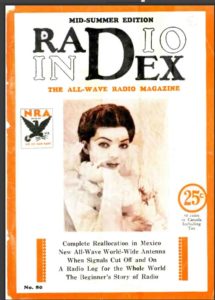
Radio Index from Summer, 1934. In this issue I found information I could use in a scene of Gangster Island.
1934. Radio Index was published between 1925 and 1942, and contained lists of all extant radio stations in the U.S., guides to network radio broadcast programming, technical information for radiophiles, and close-up bios of radio stars. It was part radio propaganda, part techie manual, part historical accounting of frequencies accessible in the U.S. and radio networks broadcasting locally and nationally. David Gleason at americanradiohistory.com has pulled together his own collection and contributed hard copies and scans not only of all issues of Radio Index, but also a wealth of other radio-centered periodicals.
Unwed Mothers’ Homes
Dimsdale, H. (Writer), and Newman, J. M. (Director). 1940. Women in Hiding. (Series short no. 29). Crime Does Not Pay, Metro-Goldwyn-Meyer. Available in Mann, A., et al. (Directors). Film Noir Vol. 3 Classic Collection. (DVD Motion Picture Collection). (2006). United States: Turner Entertainment Co. and Warner Bros. Entertainment Co.
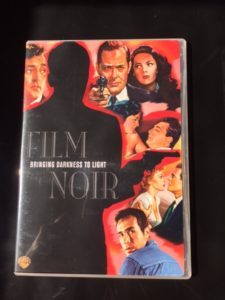
This bonus disc in the Film Noir Vol. 3 Classic Collection contains five Crime Does Not Pay shorts from MGM.
Very few people know about the dangers posed by “mothers’ homes” that took in pregnant young women in the 1930s and 40s, and apparently the phenomenon was not limited to Southern California. Although the homes advertised in local newspapers and seemed legitimate, many were little more than fronts for adoption scams. Pregnant women in these homes often received little medical attention, were forced to work long hours, and had their babies stolen from them. Because of the stigma associated with a woman being single and pregnant, women had no chance of recovering children they’d never planned to give up. The problem became so endemic that the leading movie studio of the day, MGM, produced a public service movie short (more like a horror short) warning what might happen to women if they went to these homes. This short is part of a series entitled Crime Does Not Pay. However, even a public service film was limited by the moral high ground of the day: the film could not mention adoption, nor unmarried pregnant women. In the film, married pregnant women with husbands inexplicably missing are lured in by evil people posing as doctors and nurses, and the whole business goes up in flames—literally. Picture the fire scene in Rebecca with Mrs. Danvers as an evil nurse.
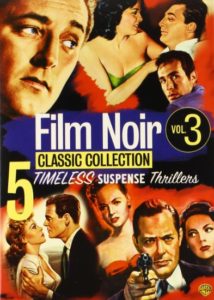 The name of the short is “Women in Hiding,” and it is available on a bonus disc in the Film Noir Vol. 3 Classic Collection, available from Warner Brothers. The image to the left is a link to the Amazon page where you can purchase the collection.
The name of the short is “Women in Hiding,” and it is available on a bonus disc in the Film Noir Vol. 3 Classic Collection, available from Warner Brothers. The image to the left is a link to the Amazon page where you can purchase the collection.
